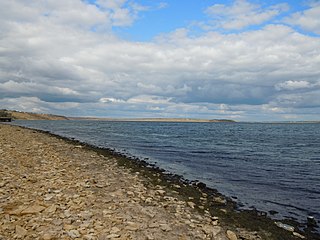
Plankton are the diverse collection of organisms found in water that are unable to propel themselves against a current. The individual organisms constituting plankton are called plankters. In the ocean, they provide a crucial source of food to many small and large aquatic organisms, such as bivalves, fish and whales.

Zooplankton are the animal component of the planktonic community. Plankton are aquatic organisms that are unable to swim effectively against currents, and consequently drift or are carried along by currents in the ocean, or by currents in seas, lakes or rivers.

The Atlantic horse mackerel, also known as the European horse mackerel or common scad, is a species of jack mackerel in the family Carangidae, the jacks, pompanos and trevallies. It is found in the eastern Atlantic Ocean off Europe and Africa and into the south-eastern Indian Ocean. It is an important species in commercial fisheries and is listed as a Vulnerable species on The IUCN Red List of Threatened Species.

Diel vertical migration (DVM), also known as diurnal vertical migration, is a pattern of movement used by some organisms, such as copepods, living in the ocean and in lakes. The word diel comes from the Latin dies day, and means a 24-hour period. The migration occurs when organisms move up to the uppermost layer of the sea at night and return to the bottom of the daylight zone of the oceans or to the dense, bottom layer of lakes during the day. It is important to the functioning of deep-sea food webs and the biologically driven sequestration of carbon.

Acartia is a genus of marine calanoid copepods. They are epipelagic, estuarine, zooplanktonic found throughout the oceans of the world, primarily in temperate regions.
Acartia lefevreae is a species of copepod belonging to the family Acartiidae. This species was discovered when specimens previously identified as Acartia clausi were examined and found to belong to a separate species. Its range overlaps with that of A. clausi, being found in the western Mediterranean and the north east Atlantic as far north as the English Channel, but it tends to be found in more brackish habitats such as estuaries.
Acartia teclae is a species of copepod belonging to the family Acartiidae. This species was discovered when specimens previously identified as Acartia clausi were examined and found to belong to a separate species. This species appears to have a similar range to, and occupies similar brackish estuarine habitats as, Acartia lefevreae but differs in the absence of spines on the dorsal part of the posterior body segment (metasome).
Acartia omorii is a species of marine copepod belonging to the family Acartiidae. This species was discovered when specimens previously identified as Acartia clausi were examined and found to belong to a separate species. This species is found around the coast of Japan. It is similar to A. clausi but lacks the prominent spines on the dorsal part of the posterior body segment (metasome).
Acartia hudsonica is a species of marine copepod belonging to the family Acartiidae. Acartia hudsonica is a coastal, cold water species that can be found along the northwest Atlantic coast.
Acartia ensifera is a species of marine copepod belonging to the family Acartiidae. This is a slender copepod, around 0.8–0.9 mm (0.031–0.035 in) in length, with distinctively long caudal rami. It is found around the coasts of New Zealand.
Acartia simplex is a species of marine copepod belonging to the family Acartiidae. This species, just under 1 mm in length, is rather similar to Acartia ensifera but can be distinguished by the presence of spines on the dorsal part of the posterior body segment (metasome). Like A. ensifera, it is found around the coasts of New Zealand, mainly in estuarine habitats.
Acartia jilletti is a species of marine copepod belonging to the family Acartiidae. This species has a total length of up to 1 mm. It is very similar to Acartia ensifera but the female can be distinguished by the shorter caudal rami and the male by the relative length of spines on the fifth pair of legs. This species has been recorded from scattered locations around the coast of New Zealand.
Acartia tranteri is a species of marine copepod belonging to the family Acartiidae. This Australian species is related to the New Zealand species A. ensifera, A. jilletti and A. simplex but can be distinguished by the lack of any ventral prominence posterior to the genital opening in the female and the presence of posterior spines on the metasome of the male. It is found off the coast of New South Wales.

Tylihul Estuary also called Tiligulskiy liman or simply Tiligul is a Ramsar listed government protected estuary or liman of the Tylihul River. Located in Odessa Oblast in the south of Ukraine, the estuary includes an ornithological Game Reserve and the Tylihulskyi Regional Landscape Park situated on the East coast.
Ellobiopsis is a genus of unicellular, ectoparasitic eukaryotes causing disease in crustaceans. This genus is widespread and has been found infecting copepods from both marine and freshwater ecosystems. parasitism has been seen to interfere with fertility in both sexes of copepods.
Acartia tonsa is a species of marine copepod in the family Acartiidae.

The lipid pump sequesters carbon from the ocean's surface to deeper waters via lipids associated with overwintering vertically migratory zooplankton. Lipids are a class of hydrocarbon rich, nitrogen and phosphorus deficient compounds essential for cellular structures. This lipid carbon enters the deep ocean as carbon dioxide produced by respiration of lipid reserves and as organic matter from the mortality of zooplankton.

Physonectae is a suborder of siphonophores. In Japanese it is called 胞泳.

Ann Bucklin is a professor at the University of Connecticut known for her work using molecular tools to study zooplankton. Bucklin was elected a fellow of the American Association for the Advancement of Science in 1995.









